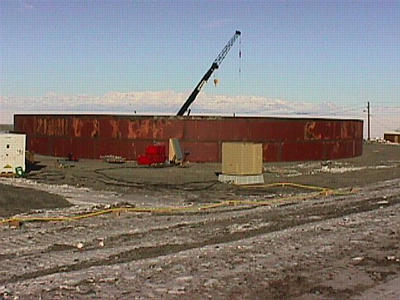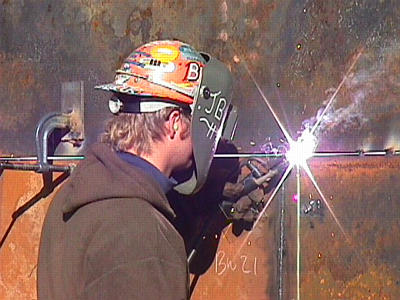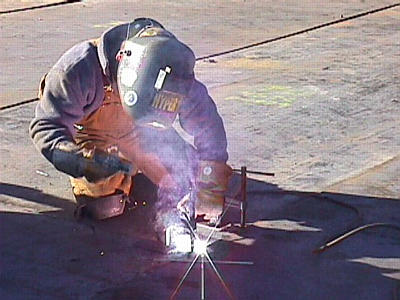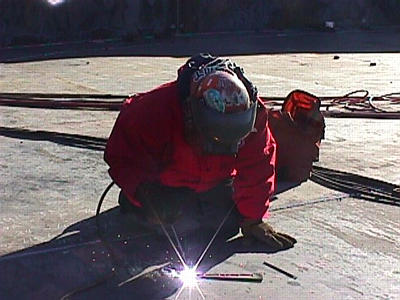6 November, 1998
Friday, November 6, 1998
Hi! I got up early this morning because I wanted to visit the site where the
new fuel tanks are being built in McMurdo. Do you remember me telling you
that I met some of the people who will be working on this project on my plane
from Los Angeles to Auckland? The welders who are building the two new fuel
tanks are hard at work right now. Cold temperatures and wind chill on Monday
made things pretty miserable for them, but the rest of this week has been a
bit milder. What helps, too, is that 2 levels of the tank are up and this
blocks the wind. These tanks are being built alongside others, on the road
that leads to Scott Base.
I walked up to the site and climbed into one of the fuel tanks…through a
circular hole on the side. Inside, I spoke with Jim Viele, who explained how
they're working to weld the pieces of the tank together. The two tanks are
being built at the same time, with 3-4 guys working in each tank throughout
the day. There are two shifts…eleven hours each. First shift runs 7:00 AM
until 6:00 PM, and second shift is 7:00 PM until
6:00 AM. These are long hours in the cold! Jim showed me how the base of the
tanks are welded, and I walked around taking photographs. You can see some at
the end of this journal, and some will be featured on the slide show. Please
be patient if pictures don't seem to match their captions….we are working on
correcting this, and it may take a few days! Thanks!
Each one of the two tanks will hold about two and a half million gallons of
jet fuel, 5 million gallons total! Jim showed me how they have to pound the
seams together as they are welding, so that they match up correctly. Right
now men are welding the bottom, sides, and outside of the tanks. Jim was
working on making a special temporary attachment to a ladder inside the tank,
which will enable him to climb up and weld seams in the second level.
I went into the tank next door and talked with Daniel Gylten, who was welding
vertical seams. He stopped to show me how to weld, and gave me the
opportunity to try it out. That was neat! I had to wear a hard hat with a
welder's hood to protect my face. I used a small piece of metal to practice
on…didn't get to do the real thing! He and Jim both talked about how much
easier it will be next year to complete additional tanks because the pieces of
metal are going to be longer and taller. The pieces shipped to McMurdo for
the project this year are smaller than the ones they generally use for this
type of tank…making the job take longer because there are a lot more seams to
weld. The two tanks currently under construction should be done before
Christmas.
I had a meeting at Crary Lab at 10:00 AM again, so I ran down to the lab. At
our daily meetings we usually get the latest news from the drill site, news
about the most recent cores sent to McMurdo, and find out what the rest of the
day has in store. I spent time up in the computer lab, but everyone quit a
little early this afternoon because the Cape Roberts scientists had a "field
trip" this evening.
What a GREAT night! We left McMurdo at about 4:30 PM, dressed in full ECW
gear, armed with a sack dinner, and riding in two Deltas. We slowly left town
and drove onto the sea ice toward Cape Evans and the ice caves. The two
Deltas traveled together for most of the trip, but as we reached a junction,
our vehicle turned off to visit the ice caves first. When we got out of the
Delta, we noticed a Weddell seal lounging on the ice nearby. She (we think it
was a she) was wounded..possibly from sliding up out of the hole in the
ice…the hole wasn't very large, but was stained with blood. She was also
rubbing a bloody spot on her body with her flipper. She made strange little
sounds…an indication that we might be too close. I photographed her from a
distance, using my telephoto lens.
Weddell seals are not streamlined…they are really fat mammals. They can reach
3 meters in length and weigh up to 400 kg. Convert that to standard
measurements will you please! The females are usually a little larger than
the males. The Weddell seal lives farther south than any other mammal. The
fast ice shelf is their main home year-round. Pups are born in colonies
during September and October, on the fast shelf ice that allows the mother
seal to access the water easily. These seals use their teeth to scrape away
ice that forms on their breathing hole. They are known to dive 60 meters
underwater, and to stay under for over an hour. They like to eat fish, squid,
and crustaceans. They are beautiful animals and I enjoyed being able to see
one up close.
Next on the agenda…into the ice caves. The larger of two caves we got to
explore had a ladder going down into it. The blue glacier ice was quite
interesting and there were unique patterns and crystals everywhere. People
had to take turns going down in the cave since space was limited. We also
needed to be careful NOT to bump into crystals and break them off. To get
into one section of the cave, we had to crawl through a very small hole…but it
led to another part of the cave that had a tall ceiling.
Soon we were loading the Delta again, and we were off to Robert Scott's hut,
from his Terra Nova expedition in 1911. It was during this expedition that
Robert Scott and four companions reached the South Pole, only to find that
they weren't the first ones there...Roald Amundsen had beaten him by just a
few weeks. Scott and his men were very disappointed and started their long
trek back to the hut on Cape Evans. They didn't make it back, however, and
died in their tent about 11 miles from one of their supply depots. The hut
was occupied by 25 men (it was a crowded place) during this expedition and it
still stands as a piece of living history… a fabulous place to learn first-
hand how these men lived and survived in Antarctica during early exploration.
I felt like I was going back in time and I could imagine what the hut would
sound like, filled with voices of men sitting around the long wooden table
that was placed in the center of the main part of the hut. I could have
stayed here for hours…I wasn't sure where to look first. I just stood
perfectly still, trying to take it all in. It took my eyes a few minutes to
adjust to the dim light, but soon things came into focus. Boxes of food, tins
of biscuits, hot cocoa mix, and many other food items were neatly stacked
around the hut. Dishes sat on shelves, cups hung from hooks, scattered on
beds were furs and items of clothing. Scientific equipment sat out on
tables…books lay open, tools were hung on the wall. Wooden ski equipment, and
other items used for traveling on the continent were visible in several
locations.
When first entering the main part of the hut, you'd be standing in the galley
and living quarters of the men (not officers) on the expedition. The officers
occupied the back section of the hut…more living space was allotted for
officers. Scott divided his men based on Royal Navy practice. Near the very
back of the hut is where Scott slept…his bunk is separated from those of two
other men by a work table…which had a faded stuffed Emperor penguin laying on
it, as well as a weather-worn open book. It is amazing to me to see these
things…preserved by the cold, dry Antarctic climate…since 1911!
I also took a look in the stable, which was attached to the main hut and
accessed by a slim corridor as you came in the main entrance. In the
corridor, tools were neatly hung on the walls, a pile of whale blubber sat on
the ground…frozen in time. I glanced around to see penguin eggs, (stored in a
box), horse grooming tools and supplies, and countless other little reminders
of the life these men made for themselves during the expedition. The ponies
didn't survive the expedition, and were shot as they became weaker and unable
to perform their duties. Outside I even found the sparse remains of a dog
that was most likely shot while it was chained up. The leather collar,
attached to a metal chain, was still around the dog's neck.
I climbed a hill to get a good view of McMurdo Sound and the hut below. On
top of the hill, a cross was a silent reminder of some of the men who have
lost their lives traveling in Antarctica. It was a lonely view these men
had…beautiful but very remote and isolated from the rest of the world.
The ride back to McMurdo took about one and a half hours…we got back earlier
than expected, so a bunch of us from the Cape Roberts project went over to the
Coffee House for awhile. Fulvia (one of the Italian women) convinced us to go
to "midrats" (midnight rations) which are served as a fourth meal of the day.
Another late night…talk to you tomorrow.
Betty J
Friday, November 6, 1998
Hi! I got up early this morning because I wanted to visit the site where the
new fuel tanks are being built in McMurdo. Do you remember me telling you
that I met some of the people who will be working on this project on my plane
from Los Angeles to Auckland? The welders who are building the two new fuel
tanks are hard at work right now. Cold temperatures and wind chill on Monday
made things pretty miserable for them, but the rest of this week has been a
bit milder. What helps, too, is that 2 levels of the tank are up and this
blocks the wind. These tanks are being built alongside others, on the road
that leads to Scott Base.
I walked up to the site and climbed into one of the fuel tanks…through a
circular hole on the side. Inside, I spoke with Jim Viele, who explained how
they're working to weld the pieces of the tank together. The two tanks are
being built at the same time, with 3-4 guys working in each tank throughout
the day. There are two shifts…eleven hours each. First shift runs 7:00 AM
until 6:00 PM, and second shift is 7:00 PM until
6:00 AM. These are long hours in the cold! Jim showed me how the base of the
tanks are welded, and I walked around taking photographs. You can see some at
the end of this journal, and some will be featured on the slide show. Please
be patient if pictures don't seem to match their captions….we are working on
correcting this, and it may take a few days! Thanks!
Each one of the two tanks will hold about two and a half million gallons of
jet fuel, 5 million gallons total! Jim showed me how they have to pound the
seams together as they are welding, so that they match up correctly. Right
now men are welding the bottom, sides, and outside of the tanks. Jim was
working on making a special temporary attachment to a ladder inside the tank,
which will enable him to climb up and weld seams in the second level.
I went into the tank next door and talked with Daniel Gylten, who was welding
vertical seams. He stopped to show me how to weld, and gave me the
opportunity to try it out. That was neat! I had to wear a hard hat with a
welder's hood to protect my face. I used a small piece of metal to practice
on…didn't get to do the real thing! He and Jim both talked about how much
easier it will be next year to complete additional tanks because the pieces of
metal are going to be longer and taller. The pieces shipped to McMurdo for
the project this year are smalled than the ones they generally use for this
type of tank…making the job take longer because there are a lot more seams to
weld. The two tanks currently under construction should be done before
Christmas.
I had a meeting at Crary Lab at 10:00 AM again, so I ran down to the lab. At
our daily meetings we usually get the latest news from the drill site, news
about the most recent cores sent to McMurdo, and find out what the rest of the
day has in store. I spent time up in the computer lab, but everyone quit a
little early this afternoon because the Cape Roberts scientists had a "field
trip" this evening.
What a GREAT night! We left McMurdo at about 4:30 PM, dressed in full ECW
gear, armed with a sack dinner, and riding in two Deltas. We slowly left town
and drove onto the sea ice toward Cape Evans and the ice caves. The two
Deltas traveled together for most of the trip, but as we reached a junction,
our vehicle turned off to visit the ice caves first. When we got out of the
Delta, we noticed a Weddell seal lounging on the ice nearby. She (we think it
was a she) was wounded..possibly from sliding up out of the hole in the
ice…the hole wasn't very large, but was stained with blood. She was also
rubbing a bloody spot on her body with her flipper. She made strange little
sounds…an indication that we might be too close. I photographed her from a
distance, using my telephoto lens.
Weddell seals are not streamlined…they are really fat mammals. They can reach
3 meters in length and weigh up to 400 kg. Convert that to standard
measurements will you please! The females are usually a little larger than
the males. The Weddell seal lives farther south than any other mammal. The
fast ice shelf is their main home year-round. Pups are born in colonies
during September and October, on the fast shelf ice that allows the mother
seal to access the water easily. These seals use their teeth to scrape away
ice that forms on their breathing hole. They are known to dive 60 meters
underwater, and to stay under for over an hour. They like to eat fish, squid,
and crustaceans. They are beautiful animals and I enjoyed being able to see
one up close.
Next on the agenda…into the ice caves. The larger of two caves we got to
explore had a ladder going down into it. The blue glacier ice was quite
interesting and there were unique patterns and crystals everywhere. People
had to take turns going down in the cave since space was limited. We also
needed to be careful NOT to bump into crystals and break them off. To get
into one section of the cave, we had to crawl through a very small hole…but it
led to another part of the cave that had a tall ceiling.
Soon we were loading the Delta again, and we were off to Robert Scott's hut,
from his Terra Nova expedition in 1911. It was during this expedition that
Robert Scott and four companions reached the South Pole, only to find that
they weren't the first ones there...Roald Amundsen had beaten him by just a
few weeks. Scott and his men were very disappointed and started their long
trek back to the hut on Cape Evans. They didn't make it back, however, and
died in their tent about 11 miles from one of their supply depots. The hut
was occupied by 25 men (it was a crowded place) during this expedition and it
still stands as a piece of living history… a fabulous place to learn first-
hand how these men lived and survived in Antarctica during early exploration.
I felt like I was going back in time and I could imagine what the hut would
sound like, filled with voices of men sitting around the long wooden table
that was placed in the center of the main part of the hut. I could have
stayed here for hours…I wasn't sure where to look first. I just stood
perfectly still, trying to take it all in. It took my eyes a few minutes to
adjust to the dim light, but soon things came into focus. Boxes of food, tins
of biscuits, hot cocoa mix, and many other food items were neatly stacked
around the hut. Dishes sat on shelves, cups hung from hooks, scattered on
beds were furs and items of clothing. Scientific equipment sat out on
tables…books lay open, tools were hung on the wall. Wooden ski equipment, and
other items used for traveling on the continent were visible in several
locations.
When first entering the main part of the hut, you'd be standing in the galley
and living quarters of the men (not officers) on the expedition. The officers
occupied the back section of the hut…more living space was allotted for
officers. Scott divided his men based on Royal Navy practice. Near the very
back of the hut is where Scott slept…his bunk is separated from those of two
other men by a work table…which had a faded stuffed Emperor penguin laying on
it, as well as a weather-worn open book. It is amazing to me to see these
things…preserved by the cold, dry Antarctic climate…since 1911!
I also took a look in the stable, which was attached to the main hut and
accessed by a slim corridor as you came in the main entrance. In the
corridor, tools were neatly hung on the walls, a pile of whale blubber sat on
the ground…frozen in time. I glanced around to see penguin eggs, (stored in a
box), horse grooming tools and supplies, and countless other little reminders
of the life these men made for themselves during the expedition. The ponies
didn't survive the expedition, and were shot as they became weaker and unable
to perform their duties. Outside I even found the sparse remains of a dog
that was most likely shot while it was chained up. The leather collar,
attached to a metal chain, was still around the dog's neck.
I climbed a hill to get a good view of McMurdo Sound and the hut below. On
top of the hill, a cross was a silent reminder of some of the men who have
lost their lives traveling in Antarctica. It was a lonely view these men
had…beautiful but very remote and isolated from the rest of the world.
The ride back to McMurdo took about one and a half hours…we got back earlier
than expected, so a bunch of us from the Cape Roberts project went over to the
Coffee House for awhile. Fulvia (one of the Italian women) convinced us to go
to "midrats" (midnight rations) which are served as a fourth meal of the day.
Another late night…talk to you tomorrow.
Betty :)

Here is one of the two fuels tanks in progress...notice the crane that is used to lift the heavy panels of metal into place.

This is Jim Vie le, one of the welders working on the fuel tanks. Jim's from North Dakota and works on many different types of tanks back in the United States. Tea ms of welders from the company they work for, travel all over the country to complete various projects. Of the 14 men down here in McMurdo working on the fuel tanks, 3 are from North Dakota, quite a few are from California, and several are from other stat es.

Daniel Gylten is shown here, welding a seam on the side of the tank. Notice that he has a protective hood over his face. As the guys are welding, they don't even use their hands to flip the hood down...they just kind of nod their head to make it drop.

Daniel's 6' 8" tall, so seeing him standing next to the panels of the tank gives you an idea of how large it is. Next year they are expecting to use panels that a re 8 feet tall and 40 feet in length.

This photo shows how the floor of the tank is being welded together. As the floor panels are welded, seams must be hammered together with a kind of mallet to ensu re that they are even. The echoes inside of the tank made the hammering sound seem a lot louder!

Here I am...getting the opportunity to try welding. Daniel gave me a small piece of scrap metal to practice on. It was interesting learning how these guys and the work they do contributes to running a small town like McMurdo.
Contact the TEA in the field at
.
If you cannot connect through your browser, copy the
TEA's e-mail address in the "To:" line of
your favorite e-mail package.
|
